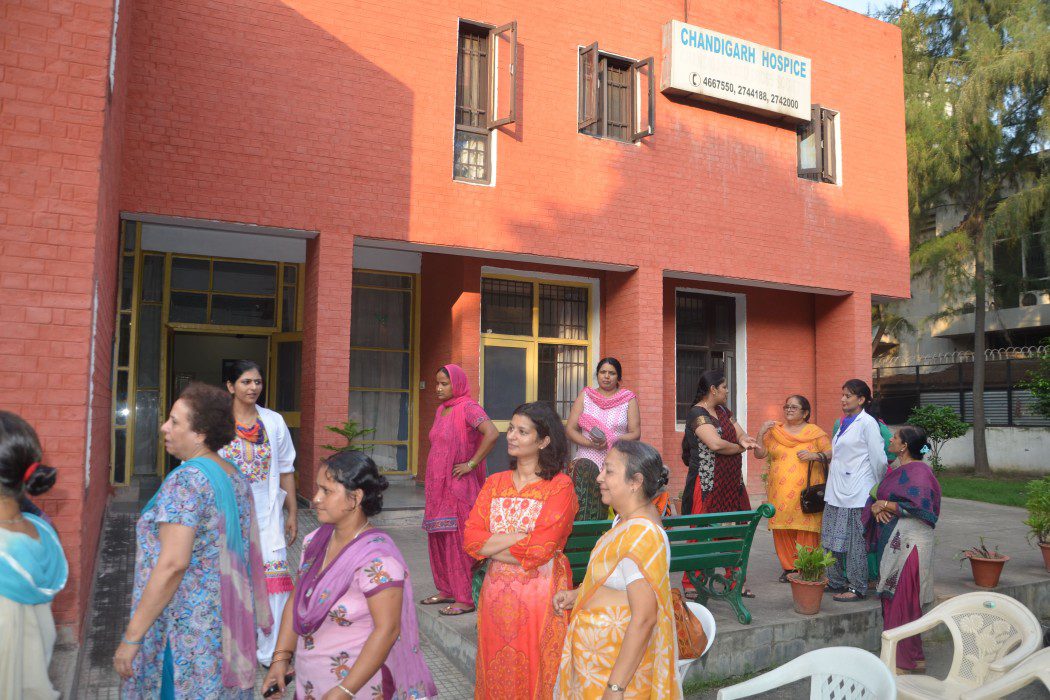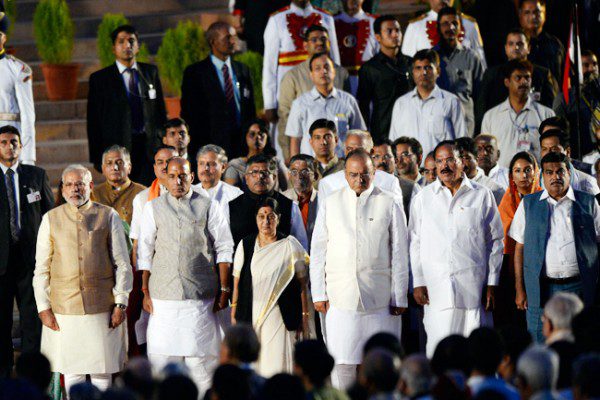Cancer is an ordeal that saps more than just the health of the patient involved. Adequate palliative care is almost as important as the treatment itself, says Ajachi Chakrabarti.
As their vehicle—too small to be called a bus, too large to be a gaddi, so they call it a gadda—pulls in to their next destination, Minni Hurria Arora and Neeru Anand look at each other and smile. Another corner plot.
It’s a pattern they’ve noticed over the years; more often than not, the houses they visit on their rounds of the cancer patients registered with the Chandigarh Hospice and Palliative Care Service tend to be corner plots. There’s no scientific basis for this, of course, but as someone who’s lived for years in a house on a corner plot in Chandigarh, I feel a slight chill up my spine.
The house we’re visiting belongs to a retired soldier who is suffering from the last stages of throat cancer. His wife offers tea; like with every house they visit, Arora and Anand wave away the offer but are eventually coaxed into having something. As she busies herself, they ask him where it hurts. He talks about how he was diagnosed, how he initially had a sore throat and a recurring cough, how his first doctor dismissed it as acidity when he claimed eating was painful, how he found a lump and decided to have it tested, how they made him keep coming back because the tests were not done or done wrong, how they kept calling him for more tests, how the pain became worse, how parts of his body began going numb.
Palliative care was originally considered to constitute only end-of-life care, when doctors would feel no more active therapy was possible.
The two know all the details, even help him tell them his story. Listening, however, forms an essential part of their work, and they let him go on before deftly steering the conversation towards how he feels today. That, after all, is the essence of palliative care—while the oncologists at the Post Graduate Institute for Medical Education and Research (PGIMER, or just PGI), the government hospital the hospice is affiliated to (in partnership with the UT Red Cross), work on fighting the cancer using the sophisticated tools at their disposal, the palliative caregivers focus on making the day-to-day ordeal of fighting cancer as painless as possible.
It’s a recent development, says Firouza Patel, a retired oncologist at PGI who now helps run the hospice. Palliative care was originally considered to constitute only end-of-life care, when doctors would feel no more active therapy was possible. Over the years, it was acknowledged that this was too restrictive a definition, that some measure of palliative care was necessary throughout the treatment, gradually increasing in importance.
That is not all. “In palliative care,” Dr Patel says, “we do not say that once the patient dies, treatment is over. Because in palliative care, unlike other diseases, we don’t only treat the patient. For us, the unit of care is the whole family. Therefore, bereavement support is very important for palliative care.”
The physical pain caused by the malignant tumour is only one aspect; there is also financial, social and emotional suffering associated with cancer. There are momentous decisions involved in fighting against cancer, probabilities to be balanced, cost-benefit analyses to be conducted.
The expanded definition of palliative care necessitates an expanded definition of pain. The physical pain caused by the malignant tumour is only one aspect; there is also financial, social and emotional suffering associated with cancer. There are momentous decisions involved in fighting against cancer, probabilities to be balanced, cost-benefit analyses to be conducted. Through frank but sensitive counselling, by talking to the families as well as the patients themselves, using their considerable experience in both treatment and management of cancer, the specialists at the hospice help make these decisions as clear-headed as possible.
The home visits are an important part of the regimen. The common experience of cancer patients, regardless of social strata, is of occasional visits to the hospital for radiation or chemotherapy punctuated with long spells at home, where the family is the primary caregiver. This often means that the patient’s progress remains unmonitored for months on end, or that their relatives find it difficult to provide adequate care. Also, especially in the case of a busy hospital like PGI, which sees patients from all over the country, patients often get too little face-time with the doctor to answer their individual concerns.
The palliative care specialists, however, cultivate a relationship with the patients and their families, and address these concerns, whether medical or logistical. To encourage familiarity, they have an office right opposite the out-patient ward at PGI, and interact with the patients from early on in the treatment. “When the diagnosis is made,” says Dr Patel, “the patient needs maximum emotional support at that time.”
“When the diagnosis is made,” says Dr Patel, “the patient needs maximum emotional support at that time.”
In other hospitals, she adds, where the palliative care team is separate and focused on end-of-life care, their entry makes the patient feel that the doctors have given up on them. The team periodically visits patients in Chandigarh, the frequency depending on the stage of the disease and the severity of the pain, while outstation patients can be admitted in the 20-bed hospice. It’s not necessary for the treatment to be ongoing at PGI; patients from other hospitals can also sign up for palliative care.
The retired soldier, for instance, is a patient at Fortis, and couldn’t come in person to PGI to see the doctors there. His wife had brought his test results and prescriptions, and Arora and Anand are here to check if the new medicines are working. The pain has marginally lessened, he says, though still very bad. But he’s strong inside, his wife says, a fauji through and through.
Arora enquire about his diet, his urine and stool, urges the wife not to overdo exercising his left arm, which has been numb since the radiation three days ago, advises her to keep the cold out so as not to exacerbate the pain. She counsels the couple on the state of the cancer, on what treatment lies ahead. She tells them they’ll be back in a week to check up on him, and will conduct tests in a month to determine the future course of action. She urges him to keep taking the medicines, tells him they’ll change the dose if required.
“Pher ho jayega?”
“Ki ho jayega? Dard ghat ho jayega.”
“Nahin. Cure poora ho jayega?” The fauji laughs as he says this; he knows the futility of asking the question.
“Dekho uncle, cure di gal aundi hai, toh sugar di bimari cure hundi hai? BP di bimari cure hundi hai? Arthritis cure hunda hai? Main maksad ki hai?”
“Kaabu karna,” the wife chimes in. “Cure ni karna, control karna hai.”
“Par ohse tuhanu taqleef na ho, wohi maksad hai. Tussi enna pareshan na raho. Dard na ho, chain se so lo. Baaki chaar hafte baad pher review karange, pher assess karange.”
A resolution adopted by the executive board of the WHO last year recognised palliative care as “fundamental to improving quality of life, well-being, comfort and human dignity for individuals, being an effective person-centred health service that values patients’ need to receive adequate, personally and culturally sensitive information on their health status, and their central role in making decisions about the treatment received”. The resolution called for the organisation to “work with Member States to encourage adequate funding and improved cooperation for palliative care programmes and research initiatives”.
In October, the hospice was certified by the European Society of Medical Oncology for “achieving a high standard of integration of medical oncology and palliative care”, one of seven such centres in India. However, it remains the only such facility north of Delhi, despite this being a relatively low-investment model.
The WHO last year recognised palliative care as “fundamental to improving quality of life, well-being, comfort and human dignity for individuals”.
In The Emperor of All Maladies: A Biography of Cancer, Siddhartha Mukherjee quotes from an essay by Maggie Keswick Jencks, a breast cancer patient, called ‘A View From The Front Line’:
There you are, the future patient, quietly progressing with other passengers toward a distant destination when, astonishingly (Why me?) a large hole opens in the floor next to you. People in white coats appear, help you into a parachute and—no time to think—out you go.
You descend. You hit the ground. . . . But where is the enemy? What is the enemy? What is it up to? . . . No road. No compass. No map. No training. Is there something you should know and don’t?
The white coats are far, far away, strapping others into their parachutes. Occasionally they wave but, even if you ask them, they don’t know the answers. They are up there in the Jumbo, involved with parachutes, not map-making.
Arora and Anand are the guides on ground zero, helping the patient make sense of their terrain, chalking out the rudiments of the path they will have to take. They are a force of compassion, a calm hand on the shoulder, a voice of reason, who help people find dignity and comfort in their darkest hours. May their tribe increase.


